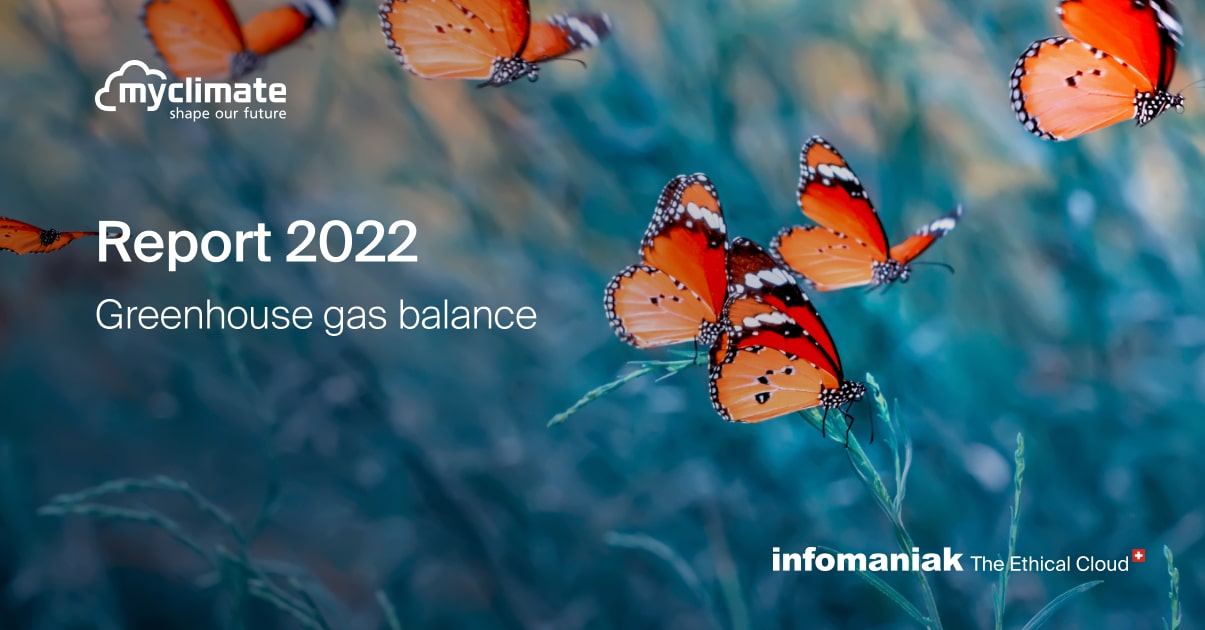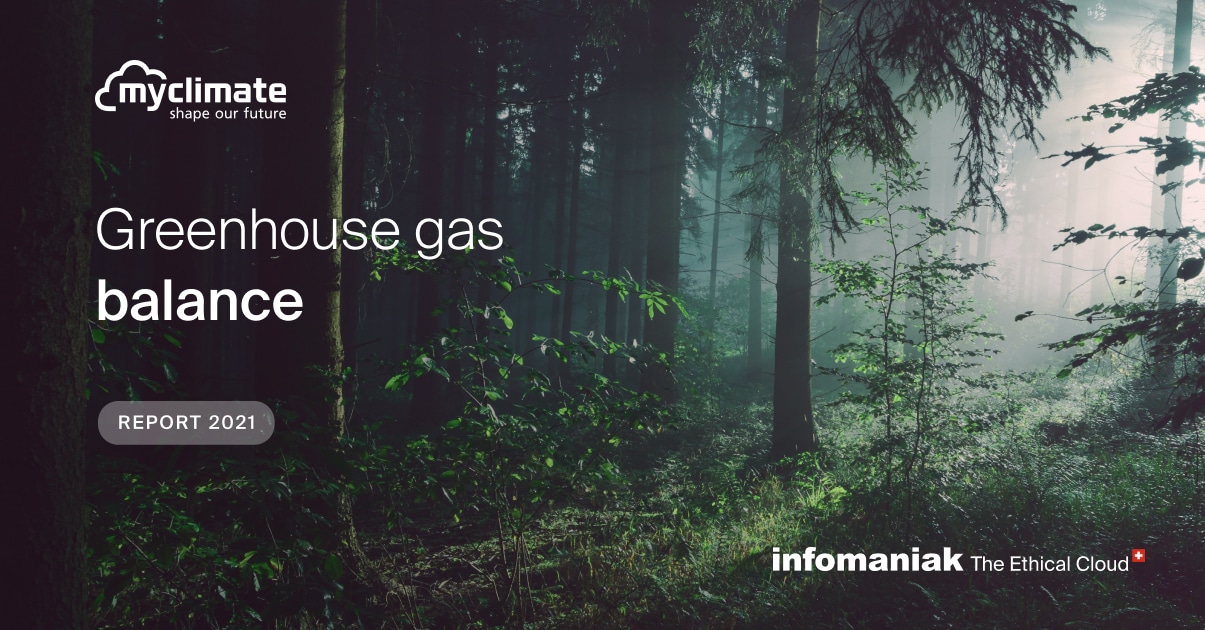Infomaniak’s new data center is a global innovation: 100% of the electricity consumed by the entire infrastructure will be recovered a second time as thermal energy to heat up to 6000 Minergie A households1. Located in a residential area, it will be buried beneath the park of an eco-district and will have no impact on the landscape.
Committed to privacy, the local economy and the environment, Infomaniak is a Swiss cloud provider recognised in Europe as an ethical and sovereign alternative to the web giants. The company is owned by some of its employees and relies solely on its customers to cover its expenses.
In this article, we reveal innovations that we believe should be the norm for any new data center. The first servers will go into operation this autumn and the heat produced will be injected into Canton Geneva’s district heating network from the first quarter of 2024.
| D4: key figures |
| 2018-2023: start of research on the site until commissioning of the first servers in autumn 2023. Heat recovery from the first quarter of 2024. |
| Budget: CHF 12 million, 50% of which is linked to heat recovery. |
Three main innovations:
|
| tCO2eq avoided at full capacity: 2785 tCO2 of natural gas or 5500 tCO2 of pellets per year. |
| At full capacity, the heat generated by this data center could heat 175 Olympic swimming pools (estimate based on raising the water temperature from 10° to 27°C). |
Meeting the digital challenges with a replicable model
1. A data center that fully recovers the energy it consumes

This new data center (D4) will recover all the energy consumed for computing and data storage. This innovation will provide 12,750 MWh at full capacity, i.e. the equivalent of 5500 tCO2 of pellets per year, to heat up to 6000 households in winter and heat domestic hot water for almost 100,000 people in summer:
“Data centers are machines that convert electrical energy into thermal energy. Currently, most data centers release this deadly heat entirely into the atmosphere. The cloud is growing fast; it is vital to put an end to this waste. Data centers need to be installed where they are needed, i.e. close to cities and district heating networks, so that the heat generated can be fully recycled, thus reducing the use of gas, wood or oil-fired power stations.”
Boris Siegenthaler, CSO and founder of Infomaniak
With this data center, we aim to recover 100% of the energy consumed. To measure this, there is an Energy Reuse Indicator (ERF), which is the ratio of energy reused to total energy consumed by the data center. The D4 will have a base ERF of 0.95 with the aim of getting as close as possible to 1.
2. A data center that operates in a closed circuit

Although the thermal performance of our data centers is already outstanding, the D4 corrects the biggest shortcoming of our existing infrastructure (and that of all industrial facilities): the loss of all energy consumed as heat to the atmosphere.
Instead of wasting the 45°C hot air from equipment and servers in the atmosphere, the new data center will inject this flow into air-to-water heat pumps; these will raise the temperature from 45°C to 67-82°C in order to adapt to the current requirements of the district heating installations of Services Industriels de Genève (SIG). As the data center operates as a closed system, all of the additional electrical energy used to operate the heat pumps is also fully recycled.
Like a fridge that dissipates heat by producing cold, the originality of this project lies in the use of both sides of the heat pumps: on the one hand, the cold released by raising the water temperature is used to keep the air passing through the servers at around 28°C and, on the other hand, the adapted heat is transmitted to Canton Geneva’s heating network to heat households and their domestic hot water.
In short, the device that recycles the energy is the same one that keeps the infrastructure at an optimal operating temperature, all without consuming any additional energy.
“Today, the PUE energy indicator for measuring the energy efficiency of data centers is no longer sufficient in the face of the climate emergency. It is important to complete it with theERF; these two indicators should be as close as possible to 1.”
Alexandre Patti, Infomaniak Compliance Officer
3. A data center in a residential area that does not impact the landscape

The data center is integrated into the heating network of a residential area of the City of Geneva, la Coopérative la Bistoquette. This makes it possible to reuse its heat all year round, day and night, summer and winter.
In addition to its dual use (data storage & calculations + heat production), this new data center will produce no nuisance and will have no impact on the landscape, since it is buried under the park of the eco-district. This avoids concreting areas outside cities for buildings that serve only one purpose.
4. Reusing renewable energy
Financially, the energy recovered from the data center is donated to SIG, the district heating operator. Only the adaptation to its operating temperatures is billed, at cost price.
To produce the 12,750 MWh that will be generated by the data center at full capacity, 2660 t of pellets would have to be burned per year, which would emit 5500 tCO2/year, not counting the 211 trucks/year with a 13 t payload (i.e. one per working day) and the microparticles associated with the transport and combustion of the pellets.
As with all Infomaniak activities, this data center is powered exclusively by renewable energy. Our energy mix currently consists of 60% hydropower (large dams) and 40% renewable energy (small dams that preserve biodiversity). We are also developing our own solar power plants2 with a capacity of 520 kWp with the aim, in the long run, of producing as much energy as we consume.
Finally, this project is developing technology literacy and European autonomy in the cloud industry. It is also contributing to developing the local economy by creating value for IT partners that supply businesses with our cloud solutions. Whenever possible, it also systematically favours Swiss and European suppliers:
- Trane heat pumps (France)
- Ebmpapst fans (Germany)
- Margen generator (Italy)
- ABB inverters (Switzerland)
- Minkels server racks (Netherlands)
- Siemens switchboard (Germany)
- Siemens power rails (Germany)
- Meyer-Burger solar panels (Switzerland/Germany)
5. Extending the service life of servers and offsetting CO2 by 200%
As we only use renewable energy, the most polluting aspect of our business is buying new servers. Instead of replacing them with new servers, we update them with second-hand components from the circular economy. Thanks to sharing technologies and cloud computing, we operate them for up to 15 years, providing our customers with exemplary reliability and performance.
Ultimately, we aim to fully and concretely offset the CO2 emissions we emit from our operations in the year following the one in which they are actually emitted.
Boris Siegenthaler, CSO and founder of Infomaniak
With regard to offsetting CO2 emissions via myclimate, we are aware that the trees that are planted do not grow in one year and that this approach could be improved, which is why we have decided to offset all our CO2 emissions twice and go far beyond climate neutrality.
The cloud industry is going in the wrong direction: not enough carbon neutrality
The promise of the cloud giants is to achieve carbon neutrality by 2025-2040, which does not necessarily mean improving energy efficiency or recovering the energy consumed. In reality, their infrastructure and data center projects raise many issues. Even if the pressure is increasing, hyperscalers’ data centers do not meet the challenges of our industry:
- No or little energy recovery.
- Air conditioning in server rooms.
- Coal–fired power plants for data centers.
- Millions of litres of water wasted to cool servers.
- Concreting of surfaces confiscated from agriculture or natural ecosystems for giga data centers.
- Remote location away from agglomerations, which prevents or complicates energy recovery.
- Controversial technologies such as data centers in the oceans, powered by hydrogen cells or cooled by lake water.
All this for economic spin-offs that elude local economies, as they are captured by companies based on other continents.
A different paradigm is possible with political will and binding laws
The cloud industry has a major role to play in energy and climate protection.
To reduce the impact of our industry, it is imperative to establish binding laws for:
- Companies building data centers
- Providers that lease and operate the IT capabilities of data centers
- Authorities granting permits to build new data centers
Authorities should set thresholds on:
- The energy efficiency of data centers, to stop or reduce the air conditioning of server rooms.
- Recycling the energy consumed by data centers, to stop an enormous amount of energy wastage.
- The location of the data centers, to reduce their footprint on the ground and ensure the complete recovery of the energy they consume, summer and winter).
When choosing your cloud provider, it is important to give preference to operators whose efforts are equal to the environmental challenges facing us:
- Energy upgrading throughout the year with an ERF close to 1
- Maximum energy efficiency with a PUE close to 1
- Data centers close to cities, and underground
- Compensation of CO2 emissions to 100% or more
- Use of renewable energy only
- Servers and equipment used for as long as possible
Innovative and complex, this data center paves the way for similar or even more ambitious projects.
“The aim of this data center is to be replicable in our industry. This know-how will not be sold. This is our fourth data center since 2000 and the goal is always to go further to reduce our impact on climate and biodiversity.”
Boris Siegenthaler, CSO and founder of Infomaniak
Supporting virtuous cloud providers and establishing stricter laws will accelerate the disappearance of obsolete technologies to ensure a more sustainable and virtuous cloud for the local economy.
***
1. Minergie is a Swiss construction label for new and renovated buildings. It guarantees a high-quality building envelope, systematic air renewal, above-average thermal protection and comprehensive quality assurance. Minergie A buildings are also characterised by very low energy requirements and a maximum share of renewable energy. Find out more
2. Infomaniak’s solar power plants are equipped with sustainable, high-efficiency and low-carbon Meyer-Burger modules. These are developed in Switzerland and manufactured exclusively in Germany with European components and suppliers wherever possible. Find out more
3. To learn more about water consumption by the data centers of the web giants: the impact of AI on the water consumption of data centers and some figures on the consumption of drinking water by Microsoft and Google to cool their infrastructures.
Infomaniak commissions two Meyer Burger solar power plants manufactured in Europe
Friday April 5th, 2024

 Français
Français Deutsch
Deutsch Italiano
Italiano Español
Español





You must be logged in to post a comment.